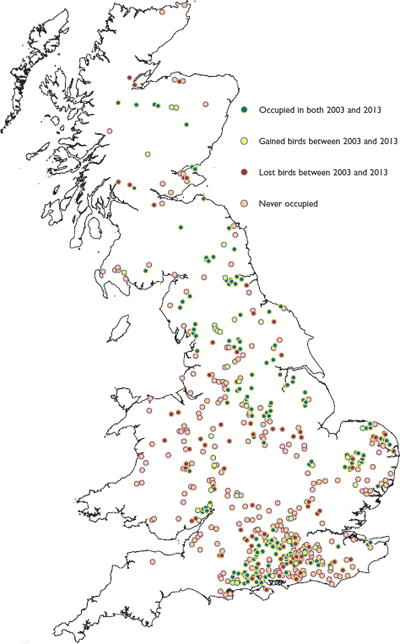Key findings
- In 2013, we conducted a repeat survey of breeding woodcock with the British Trust for Ornithology (BTO) to determine current population size and change in distribution and abundance since 2003.
- 834 randomly selected sites were surveyed for roding woodcock by more than 700 volunteer surveyors.
- The number of wooded 1x1 km² squares at which breeding woodcock were calculated to be present dropped from 35% to 22%.
- We estimate the breeding woodcock population for Britain as 55,241 males, representing a reduction of 29% in the last 10 years.
 The woodcock was ‘amber-listed’ as a bird of conservation concern in 2002 because of an apparent long-term decline in breeding numbers and range, estimated from general bird surveys organised by the British Trust for Ornithology (BTO). However, the species’ population size was unknown at the time and a crude estimate suggested just 5,000-12,500 ‘pairs’. Consequently, in 2003 we teamed up with the BTO to conduct the first national survey of breeding woodcock, employing a species-specific counting method. Our earlier work had shown that by recording the number of passes of roding male woodcock in a given time, abundance could be calculated using a calibration equation describing the relationship between roding activity and the number of individual males present (identified on a computer from recordings of their calls). This initial survey gave a population estimate of 78,350 males for Britain.
The woodcock was ‘amber-listed’ as a bird of conservation concern in 2002 because of an apparent long-term decline in breeding numbers and range, estimated from general bird surveys organised by the British Trust for Ornithology (BTO). However, the species’ population size was unknown at the time and a crude estimate suggested just 5,000-12,500 ‘pairs’. Consequently, in 2003 we teamed up with the BTO to conduct the first national survey of breeding woodcock, employing a species-specific counting method. Our earlier work had shown that by recording the number of passes of roding male woodcock in a given time, abundance could be calculated using a calibration equation describing the relationship between roding activity and the number of individual males present (identified on a computer from recordings of their calls). This initial survey gave a population estimate of 78,350 males for Britain.
Although this new, more accurate population estimate was larger than any previous estimates, we were still concerned about the likely trend in woodcock numbers. We have co-ordinated annual counts by keen volunteers at a sample of sites first surveyed in 2003, and these suggest an average decline of 4.9% per year. Coupled with the findings of the BTO’s Bird Atlas 2007-11, of a further range contraction of 29% since 1988-91, we had an indication of problems with our resident, breeding woodcock population and hence we decided that it was important to repeat the national survey in 2013.
In 2013, volunteers visited 834 random 1x1 km² squares during the breeding season. Surveys were widely spread across the UK and for the first time included sites in Northern Ireland. Based on this nationwide sample, woodcock were calculated to be present at 22% of squares containing more than 10 hectares of woodland. Northern Scotland and northern and eastern England remained stronghold areas, with between 33% and 50% of wooded squares supporting at least one roding woodcock. The lowest occupancy levels were recorded in Wales (5%), south Midlands (7%) and south-west England (6%). It is now particularly noticeable in southern England that sites occupied by breeding woodcock are clustered in areas with extensive blocks of woodland, such as the Forest of Dean, the New Forest and Thetford Forest.
Comparison with 2003 suggests a decline in overall site occupancy of 19% in the last 10 years. We observed declines in site occupancy in 10 of 11 regions, with the most severe reduction of 67% in Wales, albeit based on a small sample of sites. A small gain was recorded in northern England (16%).
Table 1: Woodcock population size estimates (males) with 95% confidence
intervals and percentage change between 2003 (Hoodless et al. 2009) and 2013.
| |
2003 |
2013 |
|
| Region |
Total |
Lower
95% CL |
Upper
95% CL |
Total |
Lower
95% CL |
Upper
95% CL |
% change |
| North Scotland |
24,088 |
14,640 |
34,633 |
23,913 |
14,796 |
33,478 |
-0.7 |
| South Scotland |
15,163 |
6,110 |
28,075 |
6,185 |
2,023 |
11,095 |
-59.2 |
| Northern England |
7,169 |
4,192 |
10,469 |
5,808 |
2,420 |
11,125 |
-18.2 |
| North Midlands |
5,139 |
2,998 |
7,612 |
3,806 |
1,188 |
7,890 |
-25.9 |
| Eastern England |
6,811 |
3,011 |
11,712 |
4,562 |
1,771 |
8,148 |
-33.0 |
| East Anglia |
3,485 |
1,747 |
5,794 |
1,791 |
1,201 |
2,465 |
-48.6 |
| South Midlands |
1,123 |
520 |
1,820 |
890 |
277 |
1,719 |
-20.8 |
| Wales |
1,767 |
541 |
3,259 |
914 |
119 |
1,900 |
-48.3 |
| South-West England |
2,234 |
774 |
4,147 |
939 |
311 |
1,683 |
-58.0 |
| Central South |
6,586 |
4,506 |
9,124 |
3,928 |
2,553 |
5,490 |
-40.4 |
| South-East England |
4,782 |
2,480 |
7,785 |
2,507 |
1,046 |
4,396 |
-47.6 |
| |
|
|
|
|
|
|
|
| England |
37,328 |
30,101 |
44,089 |
24,229 |
17,563 |
32,239 |
-35.1 |
| Scotland |
39,251 |
24,173 |
56,632 |
30,098 |
19,664 |
41,015 |
-23.3 |
| Wales |
1,767 |
541 |
3,259 |
914 |
119 |
1,900 |
-48.3 |
| |
|
|
|
|
|
|
|
| Britain |
78,346 |
61,717 |
96,493 |
55,241 |
41,806 |
69,004 |
-29.5 |
 We estimate the current breeding woodcock population in Britain to be 55,241 males. This represents a 29% decline in numbers from the 2003 estimate of 78,350. The Scottish population estimate declined from around 40,000 to 30,000 males, though the vast majority of these losses were observed in southern Scotland. In England, the population estimate fell from 37,328 to 24,299 males, representing a loss of 35%. The Welsh breeding population was low in both survey years at only 1,767 and 914 males in 2003 and 2013 respectively.
We estimate the current breeding woodcock population in Britain to be 55,241 males. This represents a 29% decline in numbers from the 2003 estimate of 78,350. The Scottish population estimate declined from around 40,000 to 30,000 males, though the vast majority of these losses were observed in southern Scotland. In England, the population estimate fell from 37,328 to 24,299 males, representing a loss of 35%. The Welsh breeding population was low in both survey years at only 1,767 and 914 males in 2003 and 2013 respectively.
From our early radio-tracking studies in the late 1980s to the early 1990s, we know that woodcock have fairly specific habitat requirements during the breeding season and therefore may be sensitive to habitat change. During 2015 and 2016, we will undertake further analyses using data on landscape composition around survey sites and information on habitat structure collected during the 2003 and 2013 surveys to understand better their influence on breeding woodcock distribution. We don’t yet understand the factors driving the decline in our breeding woodcock, but they are likely to include declining woodland management, increased browsing by deer, drying out of woods, maturation of conifer plantations, increased recreational disturbance and increased predation. As far as possible, we hope to quantify the effects of these influences in the coming years.